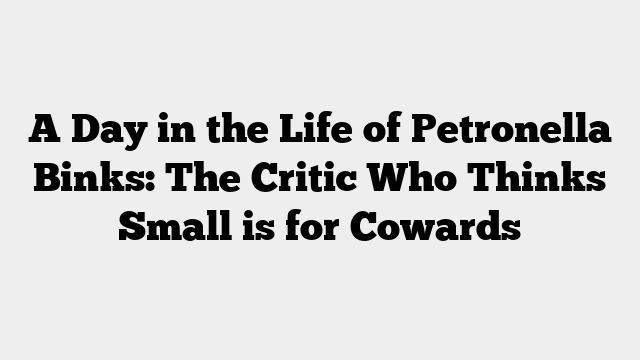Petronella Binks greets the morning the way she greets all things: with a measuring tape in one hand and disdain in the other.
“I’m not interested in art I could fit inside my vestibule,” she says, sipping black coffee from a mug that reads Go Big or Go Back to Bed. The mug is, of course, comically oversized. “If your piece doesn’t have the gravitational pull of a small planet, I simply cannot take you seriously.”
Binks calls herself a “Maximalist critic,” though detractors, chiefly those working in A5 sketchbooks, call her “The Great Wall of Pomp.” She refuses to review any artwork under twelve feet wide, a rule she claims was “not made, but revealed” to her in a moment of “cathedral-like clarity” at the 2014 Venice Biennale. “Art,” she declares, “should require scaffolding.”
Her day begins with gallery visits, where she glides past modestly sized works with the brisk contempt of a greyhound ignoring a Chihuahua. At the Turner Contemporary last week, she bypassed a series of intricate watercolours entirely. “I’m sure they were delightful in the way tea cosies are delightful,” she remarked. “But I’m here for scale – scale, darling is the soul’s megaphone.”
By noon, she’s installed in her office, a converted warehouse with ceilings high enough to echo, where she writes reviews that read like both battle reports and opera libretti. “A proper canvas should command you,” she types furiously, “not beg you to lean closer like a needy dinner guest.” In Binks’ mind, the modern plague is “whisper art”, small, understated works that “speak in lowercase and expect you to be impressed.”
She is not without her contradictions. On one hand, she insists on “the tyranny of enormity.” On the other, she rails against artists who “inflate without purpose,” comparing one recent exhibition to “a pancake that thinks it’s a parachute.”
Petronella winds down her evenings at openings, where she is a feared presence. “If the paintings are less than twelve feet, I don’t cross the gallery’s threshold,” she says, sipping champagne while visibly measuring a triptych with her eyes. The artists hover nervously. One painter, emboldened by rosé, once asked if she might consider reviewing his eight-foot canvas. “I told him,” she recounts, “that asking me that is like asking a mountaineer if they’d consider climbing the slope behind the local Tesco.”
Her critics say she’s a snob. Her admirers say she’s a visionary. Petronella says: “I am the last line of defense against art that could be hung above a sofa.”
Tomorrow, she’ll be back at it, seeking works so vast they make you feel like a crumb on the tongue of a hero of Greek mythology. “Small art is for diaries,” she shrugs. “I review monuments.”





